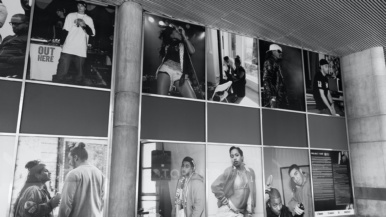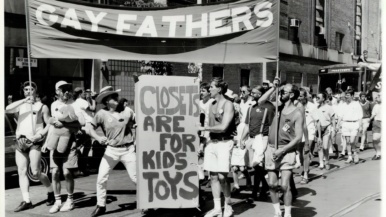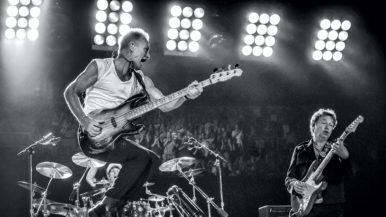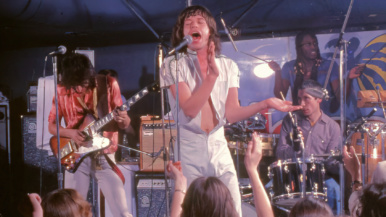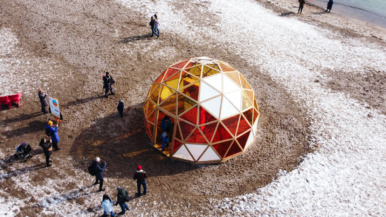Ten amazing historical photos that reveal things you may not have known about Toronto
Morgan Cameron Ross is a devoted Torontophile: he fronts a band called Bellwoods and spends his spare time combing through the city’s archives. “I am like the Drake of geeky history,” jokes Ross, who moved here from Vancouver in 2005. “I really love Toronto. It is my home now. The more people know about their community, the stronger the community is.”
Last December, Ross created Old Toronto Minutes, a hyperlocal spin-off of Canada’s beloved Heritage Minutes. The series includes minute-long YouTube videos about Superman’s connection to Toronto, Tom Cruise’s time in the Don Jail, and the history of Sneaky Dee’s. And, this month, Ross collaborated with the Myseum of Toronto to produce the first in a series of five short documentaries in the same vein—this one (embedded above) is about the late Tom Longboat, the famed Indigenous runner who trained at the west-end YMCA (now the Great Hall) before winning the 1907 Boston Marathon at 19.
Ross also runs an Instagram account called Old Toronto, where he unearths archival shots of the 6—like elephants strolling down Brock Street, or Rob Lowe rocking a Toronto-branded tank top. So we asked him to share the stories behind 10 photos of 20th-century Toronto.

Water fountain • 1899
In the late 19th and early 20th century, these stations—part horse trough, part dog bowl, part (human) water fountain—were all over the city, particularly at major intersections. This one, located at College Street and Spadina Avenue (that’s Knox College in the background), had a common cup, which people would drink from and leave for the next user.

Diving horse at Hanlan’s Point • 1908
In one of the archives’ most popular photos, a white horse dives into Lake Ontario at Hanlan’s Point, home to an amusement park and, a couple years later, a 17,000-seat baseball stadium where Babe Ruth would hit his first home run. Diving horses were a major attraction in the early 1900s, and this particular platform and horse—one in a pair called King and Queen—were part of a travelling act owned by American entertainer John W. Gorman. “This photo is really fun,” Ross says, “but it probably wouldn’t be acceptable to do that with a horse now.”

TTC employees • Early 1940s
Since its inception in the 1920s, the TTC has redesigned its uniforms every so often. In the early days, women and men had similar get-ups: ties, shirts and button-up jackets. Female employees also had their own hats: first a peaked headpiece, then a wedge cap.

Veronica Foster • 1940s
Veronica Foster worked at John Inglis Co. Ltd., a factory on Strachan Avenue (present-day Liberty Village) where she built Bren light machine guns on an assembly line. When she was about 20, she was featured in propaganda materials and became known as “Ronnie the Bren Gun girl,” a poster girl for the nearly one million Canadian women who worked in the manufacturing plants that produced munitions and material during WWII. “She’s a Canadian icon viewed as the precursor to Rosie the Riveter,” Ross says. The other posters showed Foster in more casual settings: playing baseball, dancing, doing her hair and socializing at dinner parties. After the war, she became a singer and a model.

Pilot Trainees • 1941
During WWII, the Norwegian government-in-exile, displaced from their own country by the occupying Nazis, used the island airport (Billy Bishop Toronto City Airport) as a military training base—dubbed Little Norway—for the Royal Norwegian Air Force. The camp later turned into Little Norway Park, located just north of the airport today. When the Norwegians relocated to the Muskoka Airport in 1943, the Royal Canadian Air Force began using the airport to train pilots.

VE Day • 1945
On May 7, 1945, people took to Bay Street to celebrate Germany’s surrender to the Allies, which brought an end to WWII in Europe. “It’s hard to fathom how happy people were the day after they won the war,” Ross says. “I’ve always wondered how many babies were born nine months later.”

Parkdale Theatre • 1940s
No trip to the movie theatre is complete without popcorn. But the Parkdale Theatre stopped selling the snack when they decided it was too messy. “The role of theatres was so substantial before VHS and the Internet,” Ross says. The yellow-brick building closed in 1970, was converted into an antiques warehouse and, in 2015, became the the Toronto Designers Market, a year-round bazaar.

Maple Leaf Stadium • 1947
Growing up, Ross played baseball competitively. So he was amazed to learn that the southwest corner of Bathurst and Lakeshore, now an Esso gas station and some residential buildings, used to be the site of Maple Leaf Stadium. It was home to the Toronto Maple Leafs, Toronto’s professional league baseball team, from 1926 to 1967. The only hint of its storied past is the nearby Stadium Road street sign.

University Theatre • 1963
Shortly after WWII, Famous Players built a movie theatre at 100 Bloor Street West. The University Theatre opened in 1949 with Joan of Arc. This photo was taken in 1963, when Cleopatra, starring Elizabeth Taylor and Richard Burton, was released to great fanfare. The space is now a Pottery Barn.
![Toronto Star Building, 80 King Street West. - [between 1967 and 1970]](http://torontolife.com/wp-content/uploads/2017/04/Toronto-Minutes-Downtown.jpg)
Old Toronto Star building • 1968
Although the original Superman comic series was created in Ohio in 1933, its fictional city of Metropolis was based on Toronto, co-creator Joe Shuster’s childhood city. “The little boy in me was so excited to discover that,” says Ross, who had Googled Joe Shuster because he used to live on Joe Shuster Way in Liberty Village. Shuster also modelled the Daily Planet newspaper’s office after the old Toronto Star building at 80 King Street West, where he had worked as a newspaper boy. Early issues of the comic even call it the Daily Star. The Art Deco building stood from 1929 to 1972, when it was demolished to make way for the construction of First Canadian Place.
